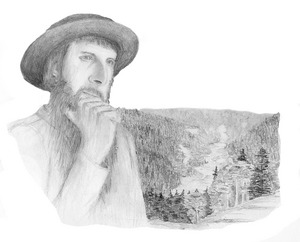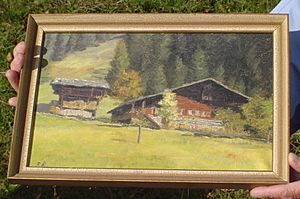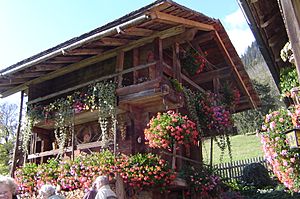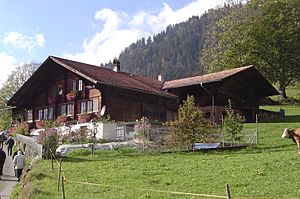Jakob Ammann facts for kids
Quick facts for kids Jakob Ammann |
|
|---|---|

|
|
| Religion | Anabaptist |
| Denomination | Amish |
| Church | Swiss Brethren, Amish |
| Personal | |
| Nationality | Swiss |
| Born | 12 February 1644 Erlenbach im Simmental, Canton of Bern, Switzerland |
| Died | Between October 1712 and 12 April 1730 (aged between 68–86) |
| Spouse | Verena (nee Stüdler) |
| Senior posting | |
| Period in office | Late 1600s – early 1700s |
| Religious career | |
| Post | Bishop |
Jakob Ammann (born February 12, 1644 – died between 1712 and 1730) was an important Anabaptist leader. The Amish religious group is named after him.
Contents
Jakob Ammann's Life Story
We don't know everything about Jakob Ammann's life. For a long time, much of what we knew was just guessing. But since the late 1990s, new research has helped us learn more. Now we have a clearer idea of his life.
Early Life and Family
Jakob Ammann was born on February 12, 1644. His birthplace was Erlenbach im Simmental, in the Canton of Bern, Switzerland. His parents were Michael and Anna Ammann. Church records from Erlenbach show a Jakob Ammann was baptized on this date. This was likely the Jakob Ammann who inspired the Amish name.
His grandfather, Ulrich Ammann, was also a tailor. Jakob and his father were tailors too. Jakob was the third of six children. He probably didn't go to school for very long. On many official papers, Jakob only used his initials. Notes on these papers often say he couldn't write well. However, his name appears on three documents. One looks like his own shaky writing. He might not have been able to read well either. Even so, he was financially better off than most people at that time.
Jakob was married to Verena Stüdler. We don't know much about her. They had at least one daughter and one son named Baltz. Jakob's father and one of his sisters also became Anabaptists. His younger brother, Ulli, was also an Anabaptist. Ulli was known for trying to make peace between the Amish and Reist groups.
Becoming an Anabaptist
In 1671, Jakob Ammann was a sponsor for a baptism in the state church. But by 1680, government letters mentioned him as someone who had "become infected with the Anabaptist sect." This is the first time we see him called an Anabaptist. This means he joined the Anabaptist faith sometime between 1671 and 1680.
Before 1693, he became a minister. He might have been chosen by Hans Reist, who later became one of his main opponents. By 1693, Ammann had moved from Switzerland to Heidolsheim, Alsace. His father died there. Soon after, Jakob moved to La Petite Lièpvre, near Sainte-Marie-aux-Mines, in Alsace. He stayed there until October 1712. At that time, King Louis XIV ordered all Anabaptists to leave the area. After this, we don't have many records about Jakob Ammann. He likely moved to live with friends or family in Lower Alsace.
When Jakob Ammann Died
We don't know exactly when or where Jakob Ammann died. In 1730, his daughter asked to be baptized in the Reformed Church in Erlenbach. She said her father had died. It's not recorded when or where this happened. Jakob Ammann became less involved in church matters before he disappeared from records in 1712. He would have been almost 70 years old when he left the Sainte-Marie-aux-Mines area.
Jakob Ammann's Beliefs and Practices
We don't have many writings from Jakob Ammann himself. Only three of his letters exist. These letters show his own thoughts. Other letters talk about his beliefs, but these were often written by people who disagreed with him. So, we need to be careful about how much we trust those accusations.
From Jakob's own letters, we learn that he was very strict. He was firm in what he believed. He expected others to "follow the teachings of Christ and His apostles." He believed that true faith meant being baptized and living a life separate from the world. He was willing to change old customs if they weren't based on the Bible. He said he wasn't trying to start a "new faith." He believed in a "new birth" experience that would truly change a person.
He also believed that men should not have long hair or shaved beards. He was against clothing that showed off pride. People who lied were to be removed from the church. Interestingly, Jakob Ammann himself had a mustache. Today, most Amish married men do not have mustaches.
The Church Split
Jakob Ammann is well-known because he was a big part of a split among the Swiss Brethren in 1693. For a long time, many people blamed him for this division. They said he was angry and bossy. But since the 1950s, more letters and information have been found. This new evidence has given Jakob Ammann a more positive reputation among some researchers. Jakob Ammann and Hans Reist were the main leaders in this split. But the problems were bigger than just these two men.
Why the Split Happened
In the mid-1600s, many new people joined the Swiss Anabaptist movement. A pastor even complained that half the people in his area were Anabaptists or supported them. These new converts were very excited about their faith. They were almost like a new group within Swiss Anabaptism. Most of the families who became Amish in the 1690s were different from those who sided with Reist.
Because of persecution, many Swiss Brethren families had to leave Switzerland. They moved to places like Alsace and the Palatinate. The authorities in these new places were often more accepting. They sometimes even welcomed the newcomers to help develop their lands. This move created different situations for the Anabaptists. This helped bring some issues to the surface.
Another important event was a meeting in 1660 in Ohnenheim, Alsace. Several Swiss Brethren ministers formally accepted the Dordrecht Confession of Faith. This confession was written by Dutch Mennonites. Before this, the Swiss Brethren only had the Schleitheim Confession. The Dordrecht Confession had two new ideas that the Swiss Brethren hadn't practiced much:
- Foot washing (Article XI)
- Social avoidance (Article XVII), which meant not eating meals with people who had been removed from the church.
The Swiss Brethren already removed people from the church and didn't share the Lord's Supper with them. But they didn't stop eating regular meals with them. These two issues, foot washing and not eating "physical" meals with excommunicated people, became central to the split.
How the Split Began
In 1693, Jakob Ammann and other ministers sent a letter to Swiss Brethren churches. They asked for a meeting to clarify three things:
- Should they avoid people who had been removed from the church?
- Should liars be removed from the church?
- Could people be saved if they didn't follow God’s word?
The last point was about "good-hearted" people. These were people who helped Anabaptists during persecution but didn't get re-baptized themselves. Ammann's group felt these people shouldn't be seen as "saved" unless they truly followed Christ and were re-baptized.
These three issues, along with foot washing, were at the heart of the division. Other issues came up later, like how often to have communion and how to discipline church members. Stricter rules about clothing and beard styles were also mentioned. But avoiding excommunicated people was the most debated issue. Sometimes, people mistakenly think it was the only reason for the split.
Removing Members from the Church
Jakob Ammann and Nicolas Augsburger were chosen to go to Switzerland. They were to meet with church leaders there. Their goal was to find out what the Swiss churches thought about the issues. At first, some Swiss ministers agreed with Ammann. But in a later meeting, Hans Reist disagreed with social avoidance. He used a Bible verse (Matthew 15:17) to say that "what enters the mouth is no sin."
Another meeting was called, but Hans Reist didn't come, saying he was busy. At this point, Jakob Ammann became annoyed. He then announced that Hans Reist was removed from the church for six reasons. Ammann asked other Swiss ministers at the meeting where they stood. They asked for time to talk with their churches. Ammann saw this as them backing down. He felt they had agreed with him before. So, he announced that six of the ministers present were also removed from the church. Ammann and the four men with him then left without shaking hands. These actions created a clear break in the Swiss Brethren movement. Eventually, Reist's side also removed Ammann's side from the church.
Trying to Make Peace
Within a few years, people tried to make peace. In February 1700, Jakob Ammann and some of his fellow ministers removed the ban from the Swiss ministers. They also said they had acted too quickly and "made a serious mistake." They didn't feel they were wrong about the issues they raised. But they felt they hadn't given Reist's side enough time to think before removing them from the church. They also felt they should have talked with the whole church before removing the Swiss ministers on the spot.
Hans Reist and some Swiss ministers seemed to accept Ammann's apology. However, they still refused to accept social shunning. Some other issues had been accepted by the Swiss ministers. But the main groups of Amish and the Reist side could never agree on social shunning.
Today in North America, the Amish and Mennonites (Reist's side became known as Mennonites) live side by side. They work together peacefully in publishing, businesses, and helping others. However, the most traditional Amish and Mennonite groups rarely share ministers or communion. In more moderate groups, the split has little effect, except for the names of their churches.
|






